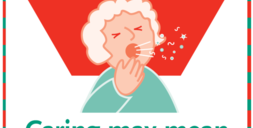Prevention
Wash your hands after using the toilet or changing diapers, before making and eating food, and before giving yourself or someone else medicine. Learn more about the importance of handwashing.
The best way to wash your hands:
- Wet hands with water and cover all parts of hands with soap.
- Rub lathered hands together vigorously for at least 20 seconds. Be sure to lather the backs of your hands, between your fingers, and under your nails.
- Thoroughly rinse with water.
- Dry hands with a clean towel.
Norovirus can be found in your vomit or poop even before you start feeling sick. The virus can stay in your poop for two weeks or more after you feel better. It’s important to continue washing your hands often during this time.
Handle and make food safely by washing fruits and vegetables before eating them and cooking shellfish thoroughly. Routinely clean and sanitize kitchen utensils, counters, and surfaces before preparing food.
If you’re sick, stay home and do not make food or care for others for at least two days after symptoms stop. This applies especially to workers in restaurants, schools, day care centers, long-term care facilities, and other places where they may expose people to the virus.
Clean and disinfect areas immediately after someone vomits or has diarrhea.
Cleaning and Disinfecting
After someone vomits or has diarrhea, immediately follow these steps to clean and disinfect the area:
- Put on rubber or disposable gloves.
- Wipe the entire area with paper towels.
- Disinfect the area using a diluted chlorine bleach solution (5 to 25 tablespoons of household bleach per gallon of water) or other disinfectant registered as effective against norovirus by the Environmental Protection Agency (EPA). See a list of EPA-approved disinfectants.
- Leave the bleach disinfectant on the affected area for at least five minutes.
- Clean the entire area again with soap and hot water.
- Finish by cleaning soiled laundry, taking out the trash, and washing your hands.
Watch the cleaning and disinfecting video.
Wash Laundry Thoroughly
Wearing rubber gloves, immediately wash soiled items carefully. Wash the items with detergent and hot water at the maximum available cycle length, then machine dry at the highest heat setting. Wash your hands after.
Outbreak Management
If you suspect an outbreak at your facility, notify the Health Department by using the Online Outbreak Report Form or by calling 802-863-7240. Refer to the quick reference guides below for long-term care facilities, schools, and child cares.
An outbreak of norovirus-like illness is when two or more people with a common exposure (like being in a school or child care) are sick within 1-2 days of each other with the abrupt onset of of gastrointestinal illness (e.g., vomiting, diarrhea). An outbreak is over when it’s been five days since the last person recovered and no additional people are sick.







